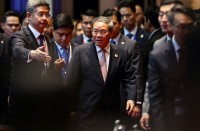MANILA (PIA)– Officials of the Association of Southeast Asian Nations (ASEAN) called for “inclusive solidarity” in responding to disasters within and outside the region.
In the recently concluded three-day (August 11-13) roadshow dubbed “One ASEAN, One Response” held in Manila, officials highlighted the importance of ASEAN member states responding jointly when one faces calamity.
The whole ASEAN region share the same disaster challenges faced by the Philippines, according to Mr. Said Faisal, executive director of the ASEAN Coordinating Centre for Humanitarian Assistance on disaster management (AHA Centre). He said ASEAN member countries need to work together in handling disasters.
The concept of a joint response to disasters by ASEAN member states will make coordination of assistance more efficient during disasters, according to Mr. Alexander Pama, executive director of the Philippines’ National Disaster Risk Reduction and Management Council (NDRRMC).
“Kapag panahon ng sakuna, imbes na kakausapin natin isa-isa ‘yong mga bansa na gustong tumulong na Asean country rin, iisang focal point na lang ang ating kakausapin which is the AHA Centre,” Pama said. “Kasi bago pa mangyari ang sakuna, nag-uusap na kami through PDRA at nabibigyan na natin sila ng mga impormasyon ng kung ano ang mga kahandaan natin dito at mga bagay na kailangan natin. Gayon din naman ‘pag magbibigay tayo ng tulong (During disasters, rather than talk to each Asean member country that wants to assist us, we only need to coordinate with a focal point which is the AHA Centre. Even before disaster strikes, we already hold PDRAs [pre-disaster risk assessment] and we send the member countries information about preparations we have put in place, and the things we need. The same is true when it’s our turn to provide assistance to others),” Pama said.
ASEAN established the AHA Centre in 2011 to be at the forefront and serve as a coordinating body of disaster assistance within the region.
The first roadshow was organized in April of this year in Jakarta, Indonesia to jumpstart the popularization of the vision “One Asean, One Response” and to seek the support of ASEAN Member States.
The Philippines lends a hand
The damages caused by past disasters in the region such as tsunami in Aceh, Indonesia in 2004, Typhoon Nargis in Myanmar in 2008, and Typhoon Haiyan in the Philippines in 2013 showed the need to prepare the Asean member states to respond to disasters.
“The Philippines (has) gained many experiences and knowledge in learning how to cope with disasters,” Faisal said. “The Asean has a lot to learn from the Philippines.”
He lauded pre-disaster efforts of the NDRRMC such as its pre-disaster risk assessment (PDRA) meetings and the comprehensive situational reports it releases to the public.
The new and bigger vision
On the average, the Asean region incurs losses due to natural disasters amounting to US$4.4 Billion.
In 2009, the member countries signed the Asean Agreement on Disaster Management and Emergency Response (Aadmer), a legal framework for all Member States which serves as a common platform in responding to disasters within the region. It aims to reduce disaster losses in the region and conduct a joint response to disaster emergencies.
Aadmer covers the whole spectrum of disaster management, from risk identification, assessment and monitoring, prevention and mitigation, preparedness, response to recovery and rehabilitation. It also promotes technical cooperation and scientific research.
To operationalize the Aadmer, AHA Centre was established to perform the most aspects under the Standard Operating Procedure for Regional Standby Arrangements and coordination of joint disaster relief and emergency response operation (SASOP) such as notification of disaster, request for assistance, offer assistance, disaster situation update, joint assessment of required assistance, mobilization of assets and capacities, and demobilization of assistance and reporting.
To support the affected country in the initial phases of a disaster emergency, the Asean-Emergency Response and Assessment Team (Asean-ERAT) was established to conduct rapid assessments, coordinate with the AHA Centre for the mobilization, response, and deployment of regional disaster management assets, and facilitate incoming relief assistance from Asean Member State. (Kristine Agustin/MnB-OpCen)







